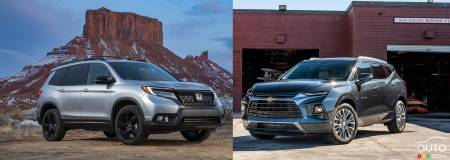Now that the big auto manufacturers have placed nearly all their eggs in the SUV basket, we’re wondering if the day will come when all conceivable market segments are covered. We know that the automakers are using all their ingenuity to create new niches, and vehicle designers are turning over every rock to make sure they don’t overlook any possibilities.
Here are two new models that fit into a newish sub-segment sitting between two existing niches. Both the Blazer and Passport are what we call five-person crossovers, larger than compact five-seaters like the Equinox and CR-V but smaller than mid-size seven-seaters like the Traverse and the Pilot.
And though this might be a freshly-minted category, it’s already populated by other models besides these two flaming-new entries, for example the Ford Edge and the Nissan Murano are also found.
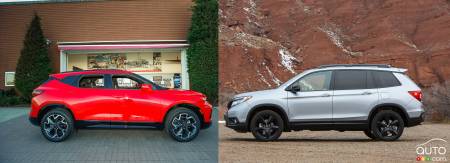
2019 Chevrolet Blazer
Creating a new niche within a niche implies having to keep costs down to make the product viable. Thus has Chevrolet used the platform of the new Acadia and Cadillac XT5
as a base for the Blazer. Likewise the engines come from the brand's toolbox.
The general lines of the reborn Blazer are not particularly inconspicuous, and only the RS version stands out with its snout that borrows features of the Camaro for its front grille and the design of the headlights. The RS models also come with chrome exhaust tips and rims. The two-tone RS treatment gives a decidedly sportier look to this version.
Our review of the 2019 Chevrolet Blazer
4 or 6 cylinders
By default the Blazer comes standard with a 2.5L, direct-injection, 4-cylinder engine producing 193 hp and 188 lb-ft of torque. For those who want more, GM’s well-known 3.6L V6 is the other option in the catalogue. That unit makes 305 hp and 269 lb-ft of torque.
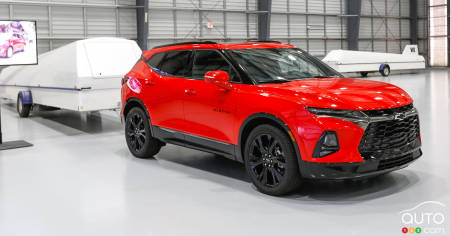
An automatic stop/start system comes standard across the range. Both engines are connected to a nine-speed automatic transmission.
By default, the new Blazer is front-wheel drive. You also have all-wheel-drive that comes in two versions. On the base models, you can opt in a conventional 4-wheel drive system that distributes power from the front to the rear. On the Premier and RS models, buyers can get a dual-clutch full-power drivetrain that not only sends power from the front to the rear, but also left to right on each axle to get the best road grip.
This torque vectoring helps the Blazer to take winding roads with impressive grace and attack a curve with extra confidence. The dual-clutch system can also be disconnected if you drive on a dry pavement, when it becomes a front-wheel drive that should save on fuel.
A techny interior
In addition to the standard 8.0-in touchscreen, the Blazer offers a multitude of USB ports, wireless charger, electronically locked glove box, heated rear seats and hands-free power liftgate.
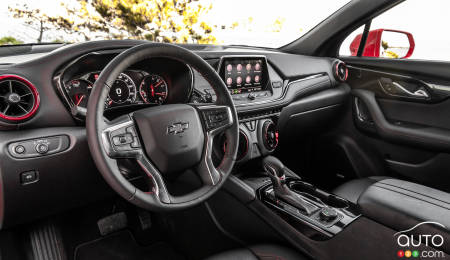
Available options include a heated steering wheel and heated/ventilated front seats that automatically operate according to weather conditions, and power windows that can be opened remotely (using the fob) to let the cabin cool down in warmer weather.
Fit and finish are quite ordinary, except in the RS model and its two-tone interior. The seats are comfortable and the space is generous overall.
Good performances - with the V6
We have yet to test out the 4-cylinder powertrain in the Blazer, and to be honest we have serious doubts as to its ability to properly haul a family of 4 with luggage. For our present comparison, we’re taking into consideration the two V6 versions.
The Premier model is more comfortable and less athletic than the RS version, which comes with stiffer shock absorbers (40% stiffer in front and 15% in the rear). The RS also gets more-responsive and more-precise steering. Put the RS in Sport mode with the AWD intelligent system and that dual-clutch transmission, and you can almost believe you’re driving a sport sedan.
Consult our listing of pre-owned Chevrolet vehicles available in your region of Canada
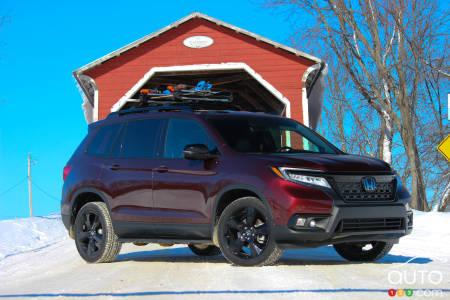
2019 Honda Passport
Some will recall the name Passport affixed to Honda’s very first mid-size SUV in the 1990s, which was in reality a rebadged Isuzu Rodeo. Like Chevrolet, which used an existing platform and engines, Honda borrowed the Pilot's architecture and engine in creating the Passport. Compared to the Pilot, the new Passport is 15 cm shorter with a slightly higher chassis. It also clearly packs more testosterone, and its demographic will probably skew more male as well as those who want a little off-asphalt adventure on the weekend.
Specifications for the 2019 Honda Passport
Our review of the 2019 Honda Passport
Only one engine
Whether you choose the Sport, EX-L or Touring version, you're entitled to one engine, the Pilot's 280-hp, 3.5L V6 (262 lb-ft of torque) with all-wheel drive and a 9-speed transmission.
The biggest difference between a Blazer and a Passport involves the space each offers. The Passport is huge, offering 1,430 litres of cargo space behind the second row and more than 2,854 litres with all seats folded down; it’s larger than some apartments I’ve seen in Tokyo.
In addition to this generous space, you get, on all models, heated seats, Apple CarPlay and Android Auto compatibility and a cavernous centre console that can swallow up a handbag or an electronic tablet effortlessly. The next level of electronic drive assist systems, navigation and ventilated seats come with the Touring version.
At the wheel
What the Passport gains in space over the Blazer, it loses in terms of handling. You can feel a certain heaviness in the steering wheel, not great when you add it on top of a lack of precision and responsiveness. The all-wheel drive is efficient and quite responsive, but a bit slow.
The driving position is excellent and you get paddle shifters on the steering wheel, but as always in these utility models they’re entirely pointless. It’s best, if you want a little more "pep", to press the D button twice to put it into Sport "S" mode; then you’ll get a bit more bite. Honda has also worked the sound of the engine to give it a more cavernous grunt, so there’s that.
Consult our listing of pre-owned Honda vehicles available in your region of Canada
Advantage Blazer
Among the Blazer models, our no-brainer choice is the RS model because one, it’s the prettiest, and two, it’s the most dynamic and fun to drive. This also gives the model its main advantage over the Passport. Thanks to the more dynamic structure, more-inspired driving dynamics and tighter steering of the RS, you almost forget you’re driving an SUV.
Advantage Passport
If space is your main concern, the Passport is the answer. With the same wheelbase as a Pilot and two seats less to cramp things up, you will not have a problem transporting a lot of goods. The Passport also offers a slight advantage in terms of towing with a maximum capacity of 5,000 lb versus 4,500 for the Blazer. With better ground clearance, it will also allow you to head for ground the Blazer wouldn’t dare tread.
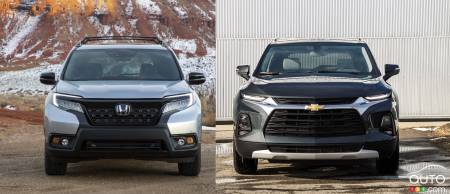
Similarities
In both cases, the models are designed for five occupants, offer comparable power in V6-engine versions, and come efficient all-wheel-drive systems. Prices are also quite similar for the models equipped with a V6.
Verdict
With a larger interior and superior loading, towing and off-road capabilities, the Passport is ideal for those seeking space and at least some adventure. With a starting price of $41,990 for a Sport version and $45,590 for the EX-L model and $48,990 for the Touring, the Passport is up to the competition that includes models like the Ford Edge, the new Blazer and the Jeep Grand Cherokee. The Passport offers more space than its competitors, proven reliability and arguably excellent resale value.
The Blazer RS, with its sleek look and sportier handling, is better for road performance and will appeal to those looking for a higher level of driving experience. The base version of the Blazer is also much cheaper than the Passport’s starting price – although we don’t much see the appeal of the denuded version with the 4-cylinder.
Which decision is best for you will depend on which of these sets of qualities is more important to you. Let’s call this one a tie.
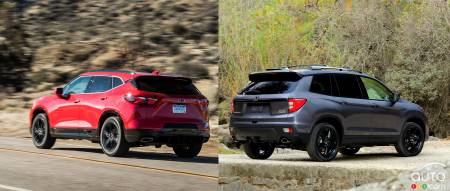
2019 Chevrolet Blazer
We like
V6 engine
9 speed dual-clutch transmission
Styling (RS)
We like less
Expensive RS version
Uninteresting base model
A little less cargo space than the Passport
2019 Honda Passport
We like
Generous space
Good standard equipment
Reliable engine
We like less
Heavy steering wheel
Too much black in the cabin
Pre-collision system too sensitive
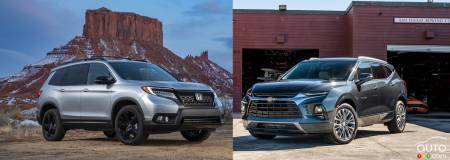
Specifications
| ... | 2019 Chevrolet Blazer | 2019 Honda Passport | |
| Transmission | 9-speed auto | 9-speed auto | |
| Drivetrain | FWD or 4WD | 4WD | |
| 4WD (V6) | 4WD (V6) | ||
| Fuel consumption (city) | 12.8L/100 km | 12.5L/100 km | |
| Fuel consumption (highway) | 9.3L/100 km | 9.8L/100 km | |
| Fuel capacity | 82 litres | 74 litres | |
| Engine | |||
| Type | Gas | Gas | |
| Output | 305 hp | 280 hp | |
| torque | 269 lb-ft | 262 lb-ft | |
| Cylinders | 6 cylinders | 6 cylinders | |
| Displacement | 3.6 litres | 3.5 litres | |
| Capacities | |||
| Cargo space | 864 l, 1 818 l | 1 430 l, 2 854 l | |
| Towing capacity | 2041 kg | 2268 kg | |
| Dimensions | |||
| Length | 4862 mm | 4839 mm | |
| Width | 1946 mm | 2279 mm | |
| Height | 1742 mm | 1835 mm | |
| Wheelbase | 2863 mm | 2817 mm | |
| Warranty | 3 yrs/60,000 km | 3 yrs/60,000 km | |
| Pricing | $35,100 to $48,700 | $41,990 to $48,990 | |


